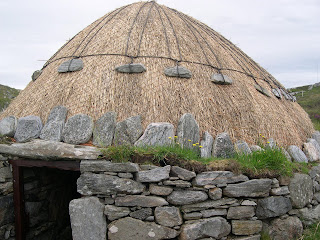
There are some great things to see. First of all, there are a couple of renovated Black House villages - Na Gearrannan being the most notable. Black Houses are so called because they had an open peat fire right in the middle, and no chimney, so everything was done in a haze of peat smoke. Pots were suspended over the fire, and the smoke rose and deposited tar in the roof beams, effectively preserving them. The houses were round-ended, built out of stones without mortar to about shoulder height, and then thatched, the thatch being traditionally weighted down with hanging stones. So the houses were low and oval, and most had various lean-to additions - in earlier times, the cattle would be brought in to the lean-to over the winter and would share the living space with the humans, and in later times the lean-to part was often used to house the loom. So all the crofter would have to do (all, she says) is work on the croft when it was possible to do so (most people grew potatoes and wheat, enough for themselves, tended sheep and one or two cows, and stacked up soil into a 'lazy bed' - flip knows why they call them that, because the people were anything but lazy - which was a long strip of soil that was fertilised with manure that the cattle built up in the lean-to over the winter and with seaweed. This was used for growing a few vegetables. In the winter, and other times when you couldn't work on the croft, a lot of people were weaving tweed on their loom in the lean-to. Most people would work for eight to ten hours a day at this, in addition to their crofting jobs. And most if not all people stopped everything on a Sunday, went to church, read the scriptures, and didn't do any more work.



The Black House in the photo is the one that's been turned into a museum at Na Gearrannan, and the rest are kitted out to be modern and luxurious inside and can be rented as holiday cottages. The museum one has benefited from the later addition of a fireplace, and so isn't peaty and smoky inside, but they keep a peat fire burning in the grate so the smell of burning peat still greets you when you go in. It's two rooms - a living/kitchen and a bedroom - and they've made it so that it looks like the people have just left. They slept in little bed boxes with curtains which look cosy and comfortable. I felt could quite easily sit in a black house and write things over the winter. Bonnie obviously felt at home too. And off the front 'hall' was a weaver working on a loom in the lean-to, surrounded by weaving and farming equipment.



Most people had moved out of Black Houses in the late fifties, and they started to fall into ruin - you'd build a 'white house', which was a stone cottage built with mortar and harled (can't remember the English word for this: is it 'rendered'?) and often whitewashed on the outside. A steep ladder staircase led up to a room in the roof. These had chimneys and were roofed with either corrugated iron or slate, and so it was the end of thatch and the end of the smoky peat fire in the middle of the room. Few of these had indoor plumbing, though, so trips to fetch water and an outhouse (or a trowel and a trip outside) were used for a loo. Further northwest along the coast is Arnol, which has a white house. Actually, inside, it doesn't look that much different, except it's much lighter: black houses may have had a couple of window openings under the thatch, but very little natural light got in. White houses had proper windows. There was a range to cook on and the floors were level, rather than being just of compacted earth and often quite uneven.
Further up the coast again (I think) there is a Norse Mill and Kiln - two little stone and thatched buildings. They're just open and you can go and have a look inside. Their construction is identical to that of the Black Houses, so little changed between - er, when were the Norsemen there? 900ish? Earlier? - and the 1950s, in terms of the building methods. The only difference I could see was that the Norse buildings had no windows at all, and were pitch black inside. I had to take a flash photo inside the kiln building to see what I was looking at. They must have worked by torchlight.

With no electricity, by the way, the houses were often lit with candles made from a pool of oil in a little hollow in a stone - often seabird oil - with a wick sticking out. Tallow candles were a luxury and didn't come in until later, and then it was paraffin. There was a scheme on Lewis, begun in the mid-19th century, to extract paraffin from peat. They even built a factory to do it, but peat isn't all that rich in paraffin and the idea was overtaken by cheaper and quicker methods from elsewhere, so paraffin began to come in by boat. Now, as I've noted before, wind power is all the talk, and there are several schemes to build big windfarms on Lewis. So far, the biggest one has been scuppered by objections from the nature conservation lobby who say that birds might fly into the turbines, particularly golden eagles, apart from environmental damage to the land caused by the building. But others argue that on an island that is desperately in need of income, and in the light of global environmental concerns about oil, gas, and nuclear energy, it is worth sacrificing the birds.

No comments:
Post a Comment